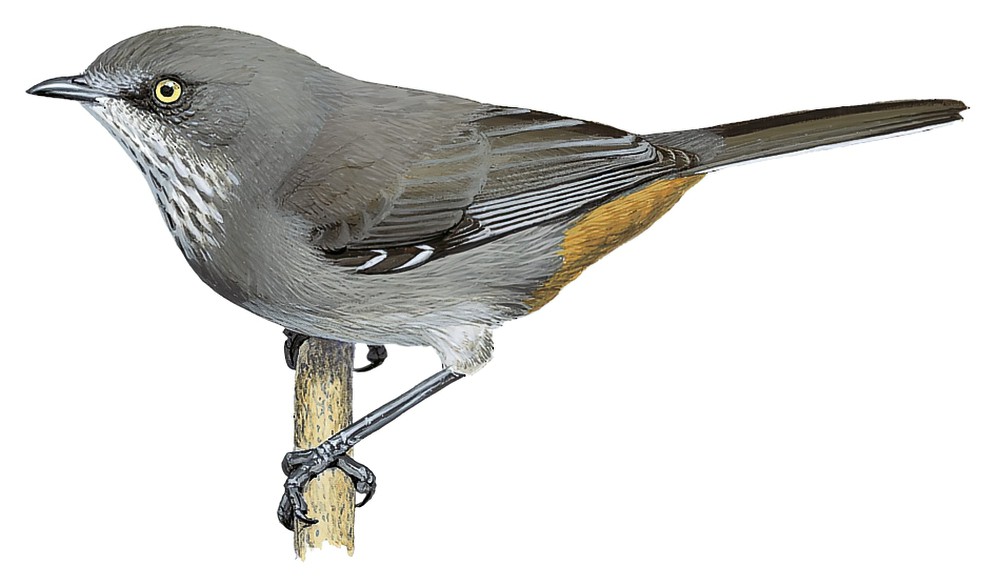Chestnut-vented Warbler / Sylvia subcoerulea

Chestnut-vented Warbler
SCI Name:
Protonym: Sylvia subcaerulea Nouv.Dict.Hist.Nat. 11 p.188
Taxonomy: Passeriformes / Sylviidae / Sylvia
Taxonomy Code: ruvwar2
Type Locality: Gourits River, Cape Province, ex Levaillant.
Author: Vieillot
Publish Year: 1817
IUCN Status: Least Concern
DEFINITIONS
SYLVIA
(Sylviidae; Ϯ Eurasian Blackcap S. atricapilla) Mod. L. sylvia woodland sprite < L. silva or sylva woodland (cf. Motacilla sylvia Linnaeus, 1766 (considered unidentifiable, but perhaps the Common Whitethroat)); "SYLVIA. Gens tenuirostris, insectivora, canora, garrula, inquieta, arboribus insidens, strigi illudens, migrans, saltitans nec ambulans, vocem nullam edens dum volat. 227. SYLVIA LUSCINIA. ... Ital. Rossignolo. Germ. Nachtigall. ... 228. SYLVIA CURRUCA. ... Ital. Bianchetto. Germ. Spottvogel. ... 229. SYLVIA ATRICAPILLA. ... Ital. Capo nero. Germ. Schwarzplatl. ... 230. SYLVIA OENANTHE. ... Ital. Cullo bianco. Germ. Steinschwazer. ... 231. SYLVIA RUBECULA. ... Ital. Petto rosso, Pitardello, Petuzzo. Germ. Rothkehlchen, Rothkröpfl. ... 232. SYLVIA PHOENICURUS. ... Ital. Scorsolato, Quarossolo. German. Rothschwänzchen, Waldrothschweifl. ... 233. SYLVIA TITHYS. ... Ital. Moretto. Germ. Hausrothschweifl. ... 234. SYLVIA ZYA. ... 235. SYLVIA SCHOENOBAENUS? ... Ital. Grisato. ... 236. SYLVIA MUSCIPETA. ... Ital. Grisatto bastardo. ... 237. SYLVIA RUBETRA. ... 238. SYLVIA TROCHILUS. ... Germ. Schmittl. ... 239. SYLVIA TROGLODYTES. ... Ital. Reatolo. Germ. Königerl, Zaunschlupferl. ... 240. SYVIA REGULUS. ... Germ. Goldhähnlein, Zaunkönig." (Scopoli 1769). "When the genus Sylvia, containing upwards of two hundred and fifty species, shall have been properly studied, it will be found practicable to divide it into several more sections, subgenera, and even perhaps genera. This bird [Sylvia palmarum], along with many other North American species, will constitute a highly natural group, very distinct from the true Sylvia, of which S. atricapilla may be considered as the type" (Bonaparte 1828); “This genus, proposed by Scopoli ... has no type designated by the author. Of later writers, Swainson in 1836 designated Sylvia hippolais (the Icterine Warbler), Gray in 1840 Sylvia melanocephala (the Sardinian Warbler), and Seebohm in 1881 Sylvia cinerea (the Whitethroat) as the types. As these three species are not to be found among those included by Scopoli in his original list of species, it is obvious that another type must be found. Motacilla sylvia Linnaeus, 1766 (= Sylvia communis Lath.), which might be regarded as the type by tautonymy, cannot be taken into consideration; it is not included in Scopoli’s original list of the members of the genus, and the identification of Motacilla sylvia with Sylvia communis is very doubtful. The Committee suggest that Sylvia curruca (Linn.) should henceforth be regarded as the type of this genus” (BOU 1915); "Sylvia Scopoli, 1769, Annus I Hist. Nat., p. 154. Type, by subsequent designation (Bonaparte, 1828, Amer. Ornith., 2, p. 17), Motacilla atricapilla Linnaeus." (Watson in Peters 1986, XI, 270).
Var. Silvia, Silvya, Slyvia, Sylcia.
Synon. Adophoneus, Adornis, Aegithalopsis, Alsoecus, Atraphornis, Communis, Corytholaea, Cuphopterus, Cuphornis, Curruca, Dagela, Epilais, Erythroleuca, Ficedula, Horizorhinus, Hortensis, Lioptilornis, Lioptilus, Melizophilus, Melophilus, Monachus, Nisoria, Parisoma, Philacantha, Philydra, Pseudoalcippe, Pyrophthalma, Sterparola, Thamnodus, Trochilus.
sylvia
Mod. L. sylvia woodland sprite, little bird, warbler < L. silva woodland.
● Roman myth. Rhea Silvia, wife to the river god Tiberinus, and mother of the twins Romulus and Remus, founders of Rome; alluding to watery habitats (subsp. Cisticola erythrops, Tanysiptera).
● Roman myth. Silvia, goddess of the forests (syn. Peneothello bimaculata vicaria).
● "99. MOTACILLA. ... Sylvia. 9. M. supra cinerea, subtus alba, rectrice prima longitudinaliter dimidiato albo, secunda apice alba. Fn. svec. 228. Habitat in Europa." (Linnaeus 1758) (?syn. Sylvia curruca).
subcoerulea / subcoeruleus
L. succaeruleus or subcaeruleus somewhat blue, bluish < sub somewhat; caeruleus blue.
SUBSPECIES
Chestnut-vented Warbler (ansorgei)
SCI Name: Sylvia subcoerulea ansorgei
ansorgeanus / ansorgei / ansorgii
Prof. Dr William John Ansorge (1850-1913) British physician in Mauritius, Uganda and Nigeria, zoologist, collector, explorer in tropical Africa (subsp. Acrocephalus rufescens, subsp. Anthoscopus caroli, subsp. Anthus leucophrys, syn. Apalis rufogularis angolensis, syn. Apus caffer, subsp. Calendulauda sabota, syn. Chlorophoneus bocagei, syn. Cinnyris reichenowi, subsp. Cisticola rufilatus, subsp. Criniger barbatus, Dyaphorophyia, syn. Eremomela atricollis, syn. Erythropygia leucophrys munda, subsp. Euplectes gierowii, syn. Euplectes progne delacouri, Eurillas, subsp. Indicator willcocksi, subsp. Lagonosticta rhodopareia, syn. Melaenornis infuscatus benguellensis, syn. Myioparus griseigularis, Nesocharis, syn. Numida meleagris reichenowi, subsp. Ortygospiza atricollis, subsp. Parisoma subcaeruleum, subsp. Parmoptila woodhousei, subsp. Plocepasser mahali, subsp. Prinia flavicans, subsp. Pterocles bicinctus, syn. Sarothrura rufa, subsp. Sylvia abyssinica, syn. Sylvia subcoerulea iohannis, subsp. Sylvietta rufescens, subsp. Tchagra australis, subsp. Treron calvus, subsp. Tricholaema hirsuta, Xenocopsychus).
Chestnut-vented Warbler (cinerascens)
SCI Name: Sylvia subcoerulea cinerascens
cinerascens
Late L. cinerescens, cinerescentis ashen < cinerescere to turn to ashes < L. cinis, cineris ashes.
● ex “Mésange Grisette” of Levaillant 1803, pl. 138 (Melaniparus).
Chestnut-vented Warbler (subcoerulea)
SCI Name: Sylvia subcoerulea subcoerulea
subcoerulea / subcoeruleus
L. succaeruleus or subcaeruleus somewhat blue, bluish < sub somewhat; caeruleus blue.
Chestnut-vented Warbler (orpheana)
SCI Name: Sylvia subcoerulea orpheana
orpheana / orpheanum
“Named P. s. orpheanum on account of its delightful song, which recalls similar outpourings by certain Sylviine warblers” (Clancey 1954) (subsp. Sylvia subcoerulea).
UPPERCASE: current genus
Uppercase first letter: generic synonym
● and ● See: generic homonyms
lowercase: species and subspecies
●: early names, variants, mispellings
‡: extinct
†: type species
Gr.: ancient Greek
L.: Latin
<: derived from
syn: synonym of
/: separates historical and modern geographic names
ex: based on
TL: type locality
OD: original diagnosis (genus) or original description (species)












